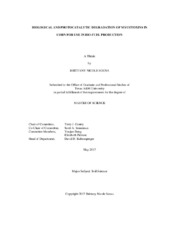| dc.description.abstract | Mycotoxin contamination of grains is a serious global problem with feed stocks often being contaminated with multiple, different mycotoxins. Many studies have successfully isolated microorganisms or used chemical and physical methods to degrade these compounds separately. It is unclear if the presence of other mycotoxins will interfere with the degradation efficiency of a particular microorganism. Chemical and physical treatments typically require high energy inputs and are linked with safety concerns. Two studies were conducted to evaluate effectiveness of two separate methods to decontaminate aqueous and corn samples containing multiple, different mycotoxins.
The first study was conducted using mixed mycotoxin substrates and an aflatoxin-degrading microorganism, Rhodococcus corynebacterioides DSM 20151. The bacterium was tested in a complex liquid medium containing: 1) 5 mg/L of AFB1, 5 mg/L of ZEA, or 5 mg/L of OTA or 2) combinations of AFB1 with each of the other two mycotoxins at 5 mg/L each. The addition of ZEA and OTA had no significant effect on AFB1 degradation by R. corynebacterioides with 100% of AFB1 degraded within 72 hours. The bacterium was also able to degrade 95% of OTA in the presence of AFB1. However, ZEA showed no degradation with or without AFB1 within 72 hours. This lack of effect on degradation and inability to degrade ZEA is likely due to the specificity of the enzymes and genes responsible for AFB1 and OTA degradation.
A second study was conducted using UV-C and the photocatalyst TiO2 to degrade AFB1, ZEA, and OTA. Aqueous and corn slurry samples containing 3 mg/L of AFB1, 3 mg/L of ZEA, and 3 mg/L OTA were tested for degradation with the following treatments: 1) UV-C only and 2) UV-C with the addition of 0.02 g/mL TiO2. After 30 minutes, UV-C was able to degrade 71% of AFB1, 61% of ZEA, and 79% of OTA in aqueous samples, whereas, with the TiO2 addition, UV-C was able to degrade 94% of AFB1, 100% of ZEA, and 97% of OTA. However, little to no degradation was observed after each treatment in corn slurry samples. These results suggest that photocatalytic degradation may be a promising method for remediation of mycotoxin-contaminated corn. | en |


